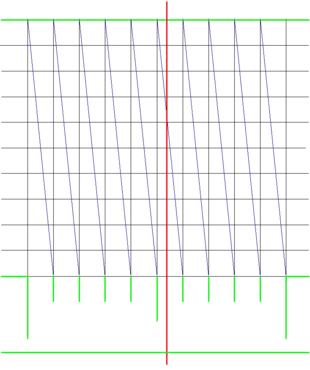.gif)
Transversal (instrument making)
Encyclopedia
Transversals are a geometric construction on a scientific instrument to allow a graduation
to be read to a finer degree of accuracy. Transversals have been replaced in modern times by vernier scale
s.
used them and did much to popularize the technique. The technique began to die out once verniers became common in the late 18th century — over a century after Pierre Vernier
introduced the technique.
In the interim between transversals and the vernier scale, the nonius
system, developed by Pedro Nunes
, was used. However, it was never in common use. Tycho also used nonius methods, but he appears to be the only prominent astronomer to do so.
 Linear transversals were used on linear graduations. A grid of lines was constructed immediately adjacent to the linear graduations. The lines extending above the graduations formed part of the grid. The number of lines perpendicular to the extended graduation lines in the grid was dependent on the degree of fineness the instrument maker wished to provide. A grid of five lines would permit determination of the measure to one-fifth of a graduation's division. A ten-line grid would permit tenths to be measured. The distance between the lines is not critical as long as the distance is precisely uniform. Greater distances makes for greater accuracy.
Linear transversals were used on linear graduations. A grid of lines was constructed immediately adjacent to the linear graduations. The lines extending above the graduations formed part of the grid. The number of lines perpendicular to the extended graduation lines in the grid was dependent on the degree of fineness the instrument maker wished to provide. A grid of five lines would permit determination of the measure to one-fifth of a graduation's division. A ten-line grid would permit tenths to be measured. The distance between the lines is not critical as long as the distance is precisely uniform. Greater distances makes for greater accuracy.
As seen in the illustration on the right, once the grid was scribed, diagonals (transverse lines) were scribed from the uppermost corner of a column in the grid to the opposite lowest corner. This line intersects the cross lines in the grid in equal intervals. By using a cursor, alidade or similar indicator of measure, the closest point where the transversal crosses the grid is determined. That indicates the fraction of the graduation for the measure.
In the illustration, the reading is indicated by the vertical red line. This could be the edge of an alidade or a similar device. Since the cursor crosses the transversal closest to the fourth grid line from the top, the reading (assuming the leftmost long graduation line is 0.0) is 0.54.
Graduation (instrument)
-Linear graduation:Linear graduation of a scale occurs on a straight instrument. The graduation can identify linear measures, such as inches or millimetres on a rule. They can also be non-linear such as logarithmic or other transcendental scales....
to be read to a finer degree of accuracy. Transversals have been replaced in modern times by vernier scale
Vernier scale
A vernier scale is an additional scale which allows a distance or angle measurement to be read more precisely than directly reading a uniformly-divided straight or circular measurement scale...
s.
History
Transversals were used at a time when finely graduated instruments were difficult to make. They were found on instruments starting in the early 14th century, but the inventor is unknown. Their use on astronomical instruments only began in the late 16th century. Tycho BraheTycho Brahe
Tycho Brahe , born Tyge Ottesen Brahe, was a Danish nobleman known for his accurate and comprehensive astronomical and planetary observations...
used them and did much to popularize the technique. The technique began to die out once verniers became common in the late 18th century — over a century after Pierre Vernier
Pierre Vernier
Pierre Vernier was a French mathematician and instrument inventor. He was inventor and eponym of the vernier scale used in measuring devices....
introduced the technique.
In the interim between transversals and the vernier scale, the nonius
Nonius
Nonius can refer to:Persons* Pedro Nunes , Portuguese astronomer and mathematician.* Nonius Marcellus, Latin grammarian and lexicographer, lived at the end of the 3rd or the beginning of the 4th century AD....
system, developed by Pedro Nunes
Pedro Nunes
Pedro Nunes , was a Portuguese mathematician, cosmographer, and professor, from a New Christian family. Nunes, considered to be one of the greatest mathematicians of his time , is best known for his contributions in the technical field of navigation, which was crucial to the Portuguese period of...
, was used. However, it was never in common use. Tycho also used nonius methods, but he appears to be the only prominent astronomer to do so.
Linear transversals

As seen in the illustration on the right, once the grid was scribed, diagonals (transverse lines) were scribed from the uppermost corner of a column in the grid to the opposite lowest corner. This line intersects the cross lines in the grid in equal intervals. By using a cursor, alidade or similar indicator of measure, the closest point where the transversal crosses the grid is determined. That indicates the fraction of the graduation for the measure.
In the illustration, the reading is indicated by the vertical red line. This could be the edge of an alidade or a similar device. Since the cursor crosses the transversal closest to the fourth grid line from the top, the reading (assuming the leftmost long graduation line is 0.0) is 0.54.

